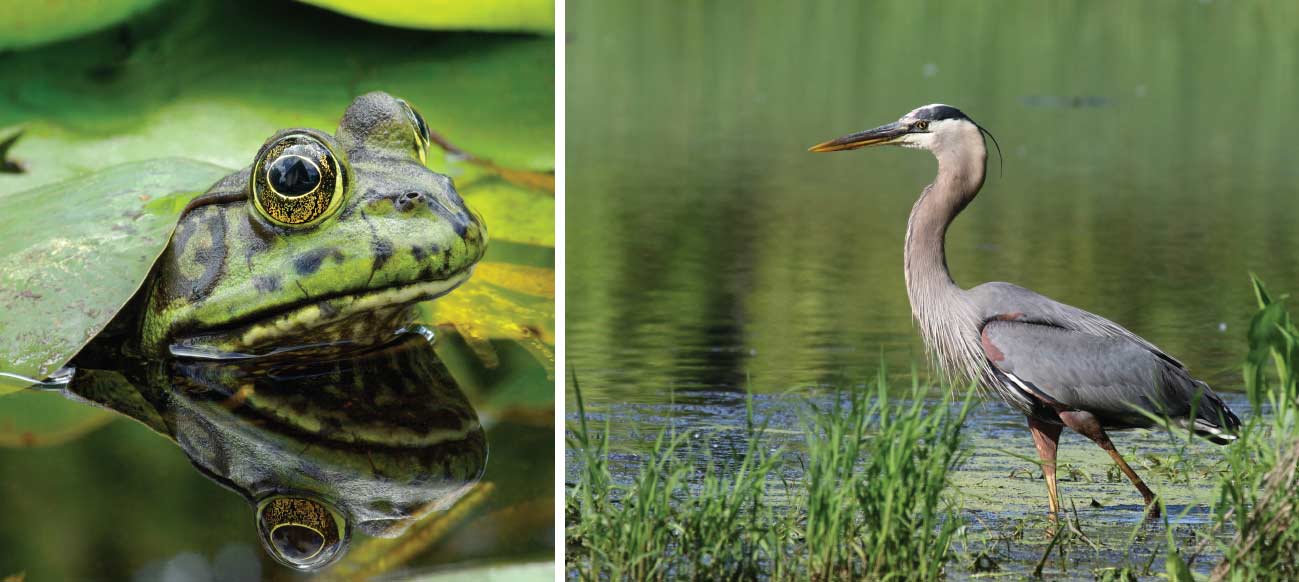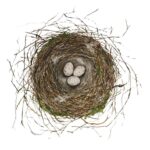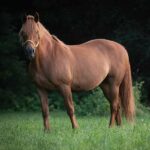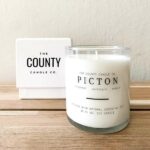
A wildlife pond can be a gift to your property’s ecosystem that can support everything from waterfowl to frogs and salamanders. But before you start digging, there are some key points to consider.
Perhaps you own a rural property, and you’ve become taken with the idea of “doing something” for nature with your land. You’ve probably already planted trees and have native perennials in your flower beds. And you long ago gave up fastidiously raking the leaves in your yard in the fall for the benefit of overwintering insects.
For the daring, and those willing to do a little work or who are lucky enough to afford someone to do it for them, the next step may be a wildlife pond.
Water is fundamental to the survival of all living things. A wildlife pond on your property will have immediate benefits to birds and mammals, which will come to drink, bathe and cool themselves. Other wildlife such as salamanders, frogs, turtles and aquatic insects will fulfill vital aspects of their life cycle in the waters and wet soils you’ll provide.
It’s important to think about what a wildlife pond is – and isn’t. For instance, it is not a fish pond. Some of the literature suggests that fish not be part of the plan, because they’ll dine on amphibians and other critters.
Your pond will, in small but important ways, help counter the enormous loss of southern Ontario’s wetlands and the important habitat they provide. In the last 200 years the province’s most inhabited region – the strip from Windsor to Cornwall – has lost 1.4 million hectares of wetland, mostly to agriculture and urban expansion. That loss continues. In just over one decade, from 2000 to 2011, southern Ontario’s wetlands declined by more than 6,000 hectares.
DEFINING A WILDLIFE POND
Before you become too enthused, it’s important to think about what a wildlife pond is – and isn’t. For instance, it is not a fish pond, which typically will be steep-sided and deep to provide the oxygen-rich cold water required by trout and other prized species. In fact, some of the literature on wildlife ponds suggests that fish not be part of the plan, because they’ll dine on amphibians and other critters.
Whatever size you make your pond, and wherever you locate it, there are features it should have. It should have lots of shallow areas, sloping gently into some that are deeper – say four feet. It should have a complex shoreline – lots of curves and little bays, maybe even an island or two. It should get lots of sunlight and have features such as large logs and big rocks where creatures can warm themselves in the sun. Where possible, allow a tree to fall into the water, with branches and limbs sticking in and out of the surface and the trunk resting on the shore. Anchor durable logs, such as oak or cedar, to the bottom so they float away from the bank. If you add rocks to the pond edge, make sure there’s some vegetation cover around them to provide shelter and food. Be sure the rock pile features at least one flat slab, angled down to the water, for critters to crawl up on.
Aesthetically, it may be nice if the pond has a water level that’s consistent. But it’s not necessary. A vernal, or seasonal pond can provide critical habitat for everything from waterfowl that fledge their young in the spring to amphibians such as frogs and salamanders. If you must have fish, give frogs and other amphibians an adjacent, shallow side pond where the fish can’t get to them.
You’ll want to plan for your own enjoyment as well. Photographers may wish to include a blind, locations for wildlife cameras to capture images of their pond’s guests, and perhaps a raised and hardened path that will get them up close to wet areas while keeping their feet dry. Wood duck boxes placed close to ponds in woodland areas will attract these brightly coloured waterfowl. Smaller boxes will attract swallows and other cavity nesters. A bat box will also attract night time visitors.
LOCATION, LOCATION, LOCATION
Where to locate the pond is an important matter. It might seem reasonable to establish the pond in the vicinity of an existing wetland, headwater spring, or stream to provide a potential water source. But wetlands, headwater springs and streams that haven’t been altered are generally better off left alone, without any attempts to “improve” their ecological benefit with a pond.
Instead, think about locating the pond on a site that’s flat, or nearly so, where some combination of groundwater and spring melt could be the water source. Soil conditions are important. Coarse-textured soils such as sand and gravel will not hold water. Look for soils with at least 20 percent clay content. A test pit will reveal much about both soil conditions and water supply. If water already stands in the proposed site for several months in the spring, perhaps all you need to do is deepen it. It’ll be beneficial if the location is quiet, away from any disturbances that will chase off wildlife.
If you add rocks to the pond edge, make sure there’s some vegetation cover around them to provide shelter and food. Be sure the rock pile features at least one flat slab for critters to crawl up on.
BRING ON THE SHOVELS
If your property doesn’t have a site with the right soils but there’s an adequate water supply, think about a smaller project lined with an impermeable man-made material. Choose the pond liner carefully. Plastic pool liners, for instance, contain materials toxic to frogs and toads and will break down quickly. Consider using reinforced polyethylene (RPE) or ethylene propylene diene monomer (EPDM). A layer of soil from the site placed over the liner will allow aquatic plants to take root.
Digging a pond, whether by hand or with machinery, requires moving considerable quantities of dirt that will have to go somewhere. Where this material goes, and how it is shaped to form a natural-looking part of the landscape around the pond, should be part of the planning process. You don’t want to have a nice wildlife pond surrounded by random heaps of dirt. Be sure, when creating the site, to keep topsoils and subsoils separate so the disrupted area can be finished with the topsoil when all the heavy lifting, piling and grading is done.
A POSITIVE CONTRIBUTION
The wildlife habitat you’re creating will be a shallow wetland that has a limited lifespan, ever changing and evolving. Over time its vegetation will die, rot, and become organic matter, which, over more time, will support more new vegetation until it fills in, perhaps to become a vernal pool in a forest and then eventually disappear. This is the natural order of things.
However, you want to slow this process down as much as possible for the benefit of wildlife and your own enjoyment. If there are grazing animals on the property, they need to be kept well away from the pond with a fence. A naturalized buffer area around the pond will reduce the impact of the nutrients they might add, and also minimize the impact of fertilizers spread on nearby fields.
Pond builders take different paths towards re-establishing vegetation in and around their projects. Some let nature make the decisions, while others plan and purchase native wetland plants such as marsh marigold, sedges, sweetflag, pickerel weed and many more. For a comprehensive list, go to the Toronto Zoo website and search for “native wetland plants.”
Damp soils around the pond provide unique opportunities for plants, including some that are pollinator magnets. Joe Pye Weed is a late blooming wildflower that grows in clumps up to seven feet high. Other flowering natives include blue lobelia, monkey flower, sneezeweed and dense blazing star. Red-osier dogwood is a native shrub that will lend colour to your pond site in all seasons.
As your pond grows in, watch for invasive plants. Flowering rush, phragmites and purple loosestrife all look pretty and may make you think you want them in your pond area. But you don’t. They will take over and ruin your project. Learn to identify invasives and root them out as soon as they appear.
Creating a wetland pond requires some planning and work. But if you enjoy wildlife and wish to make a positive contribution to Ontario’s biodiversity, it can provide you with years of enjoyment and satisfaction.
Story by:
Norm Wagenaar




